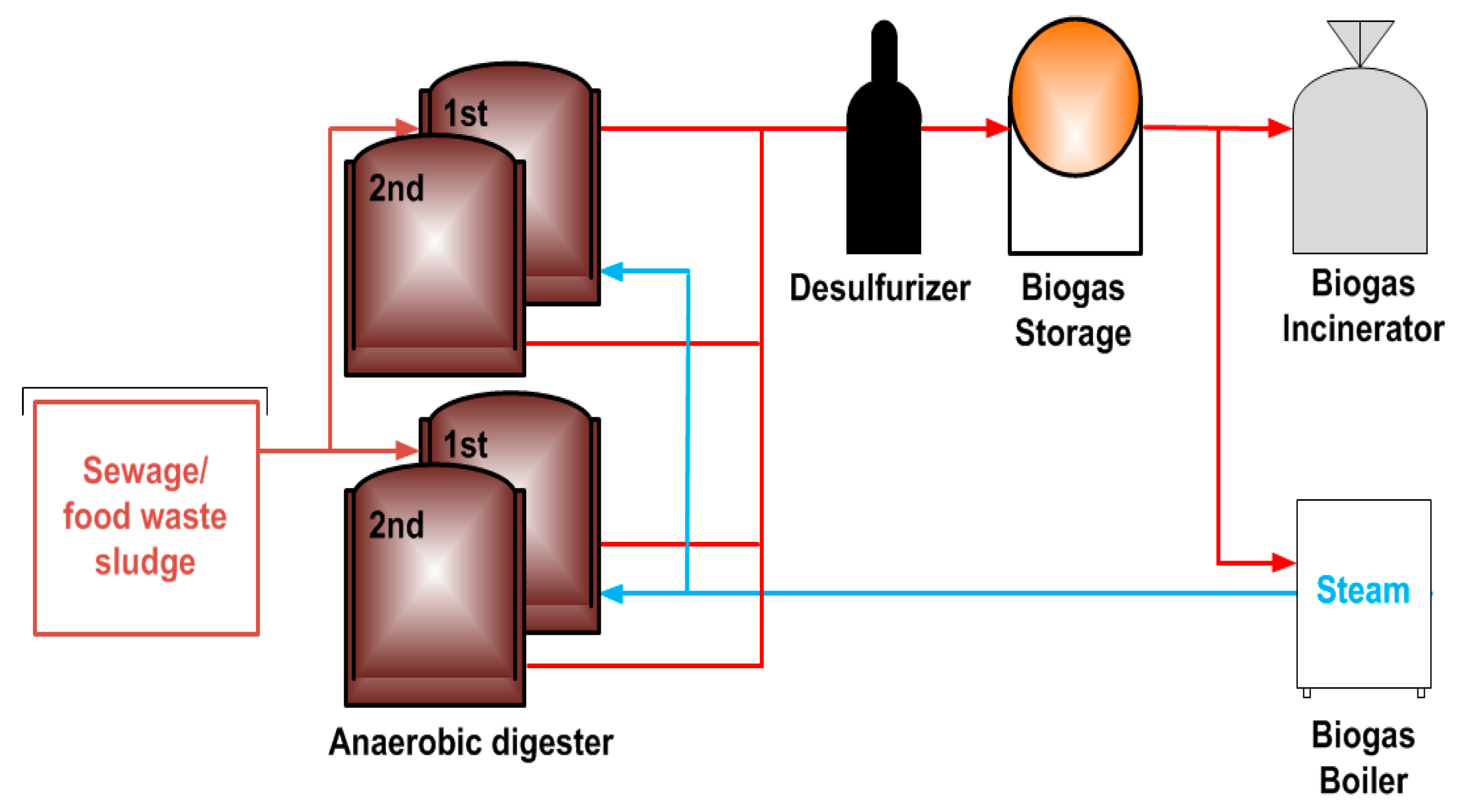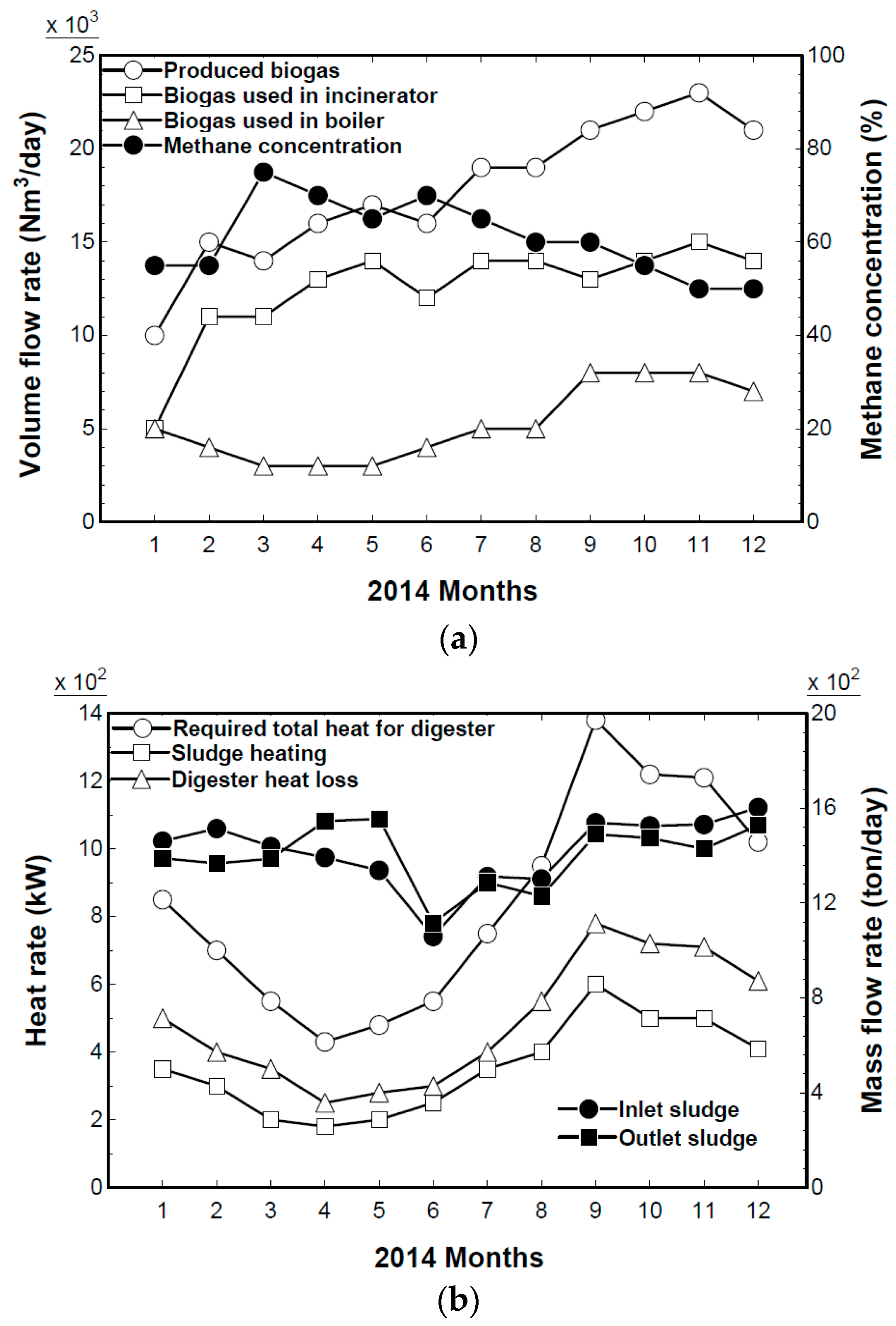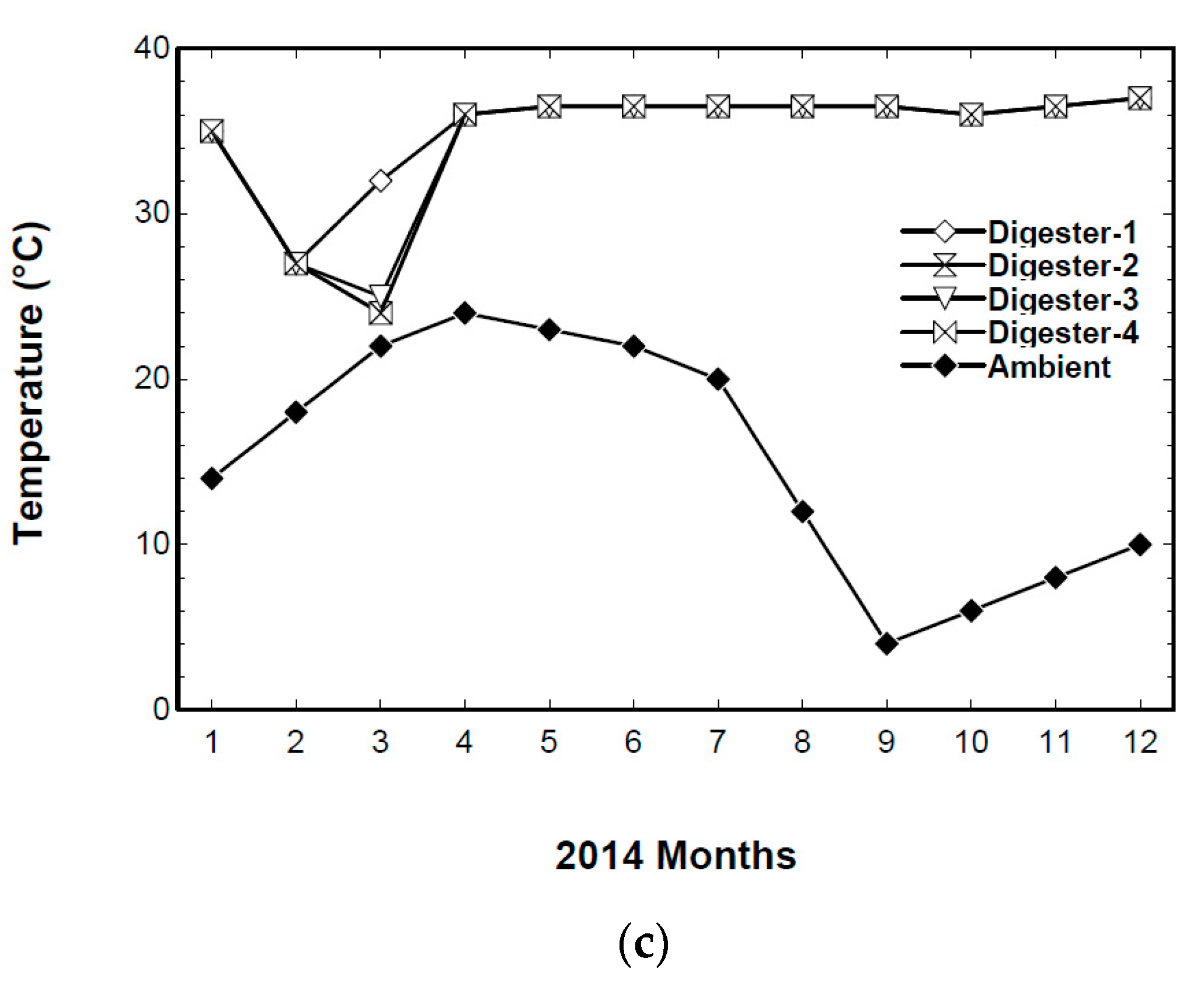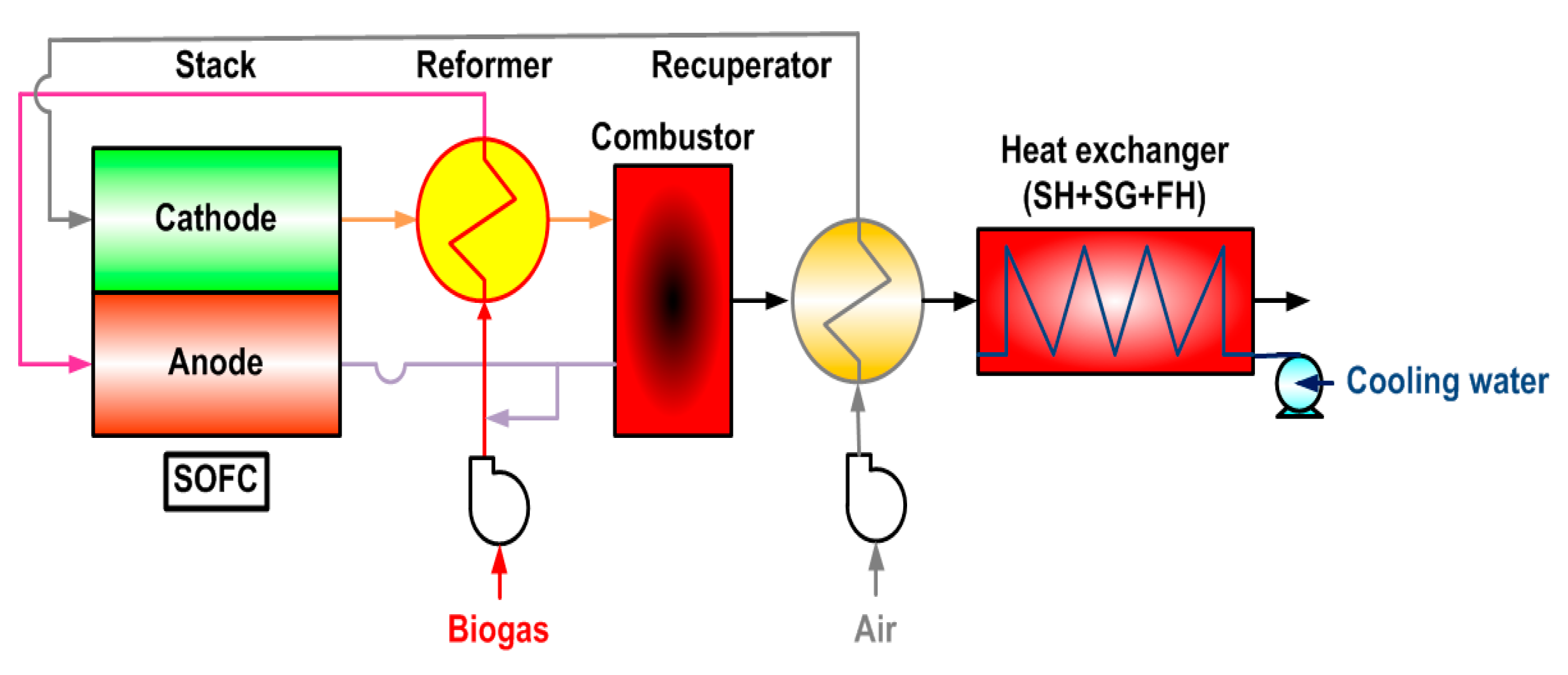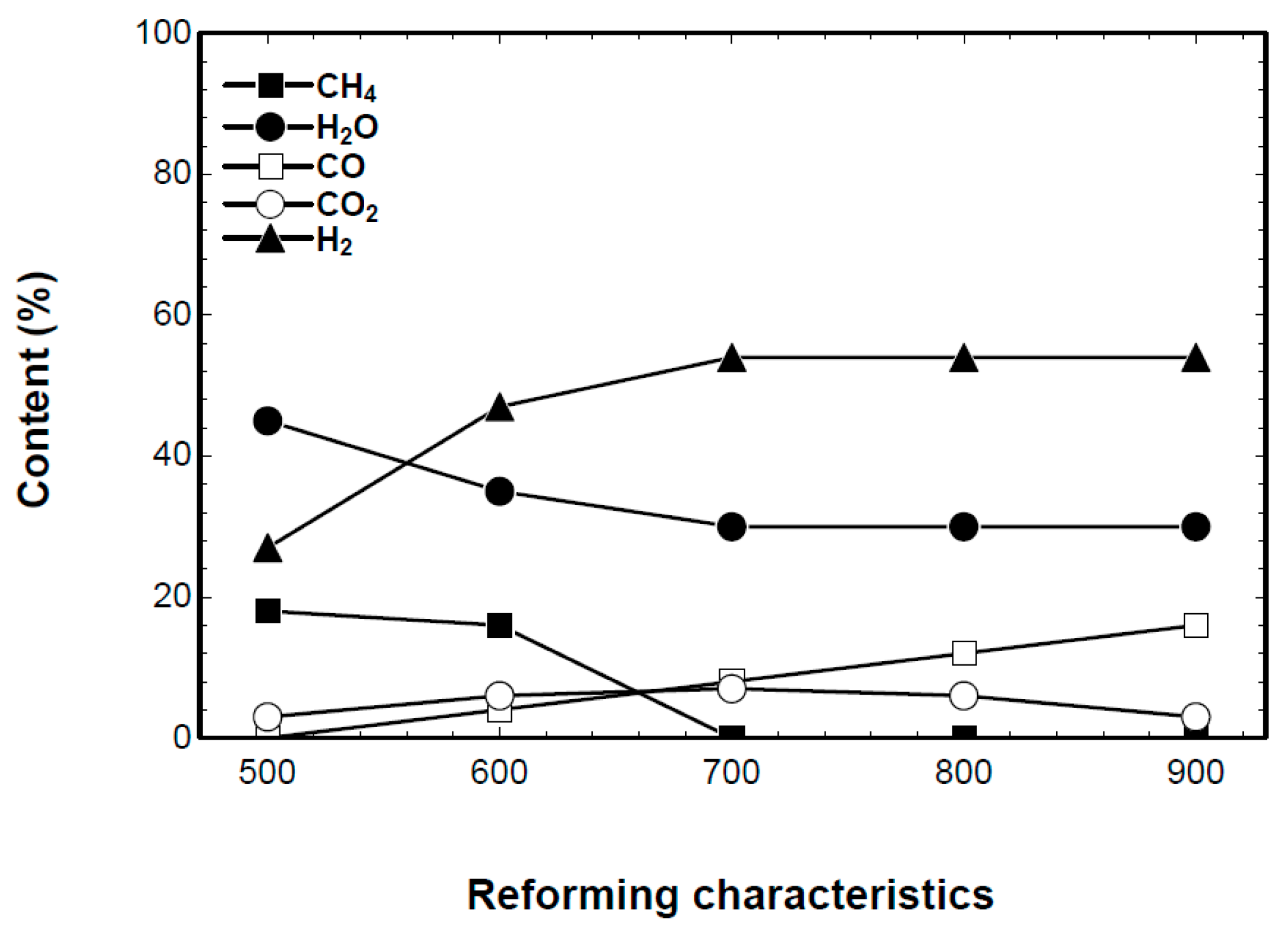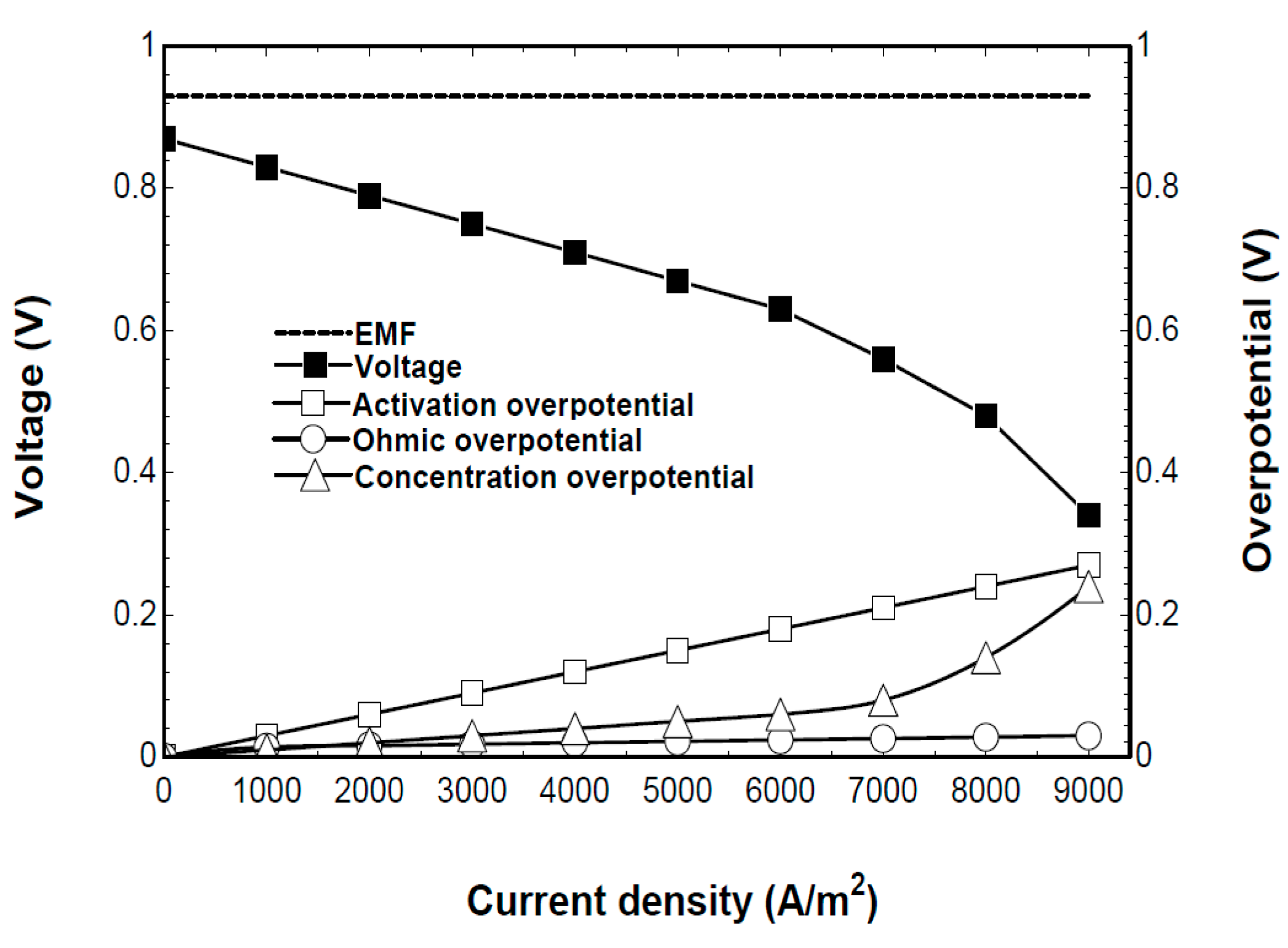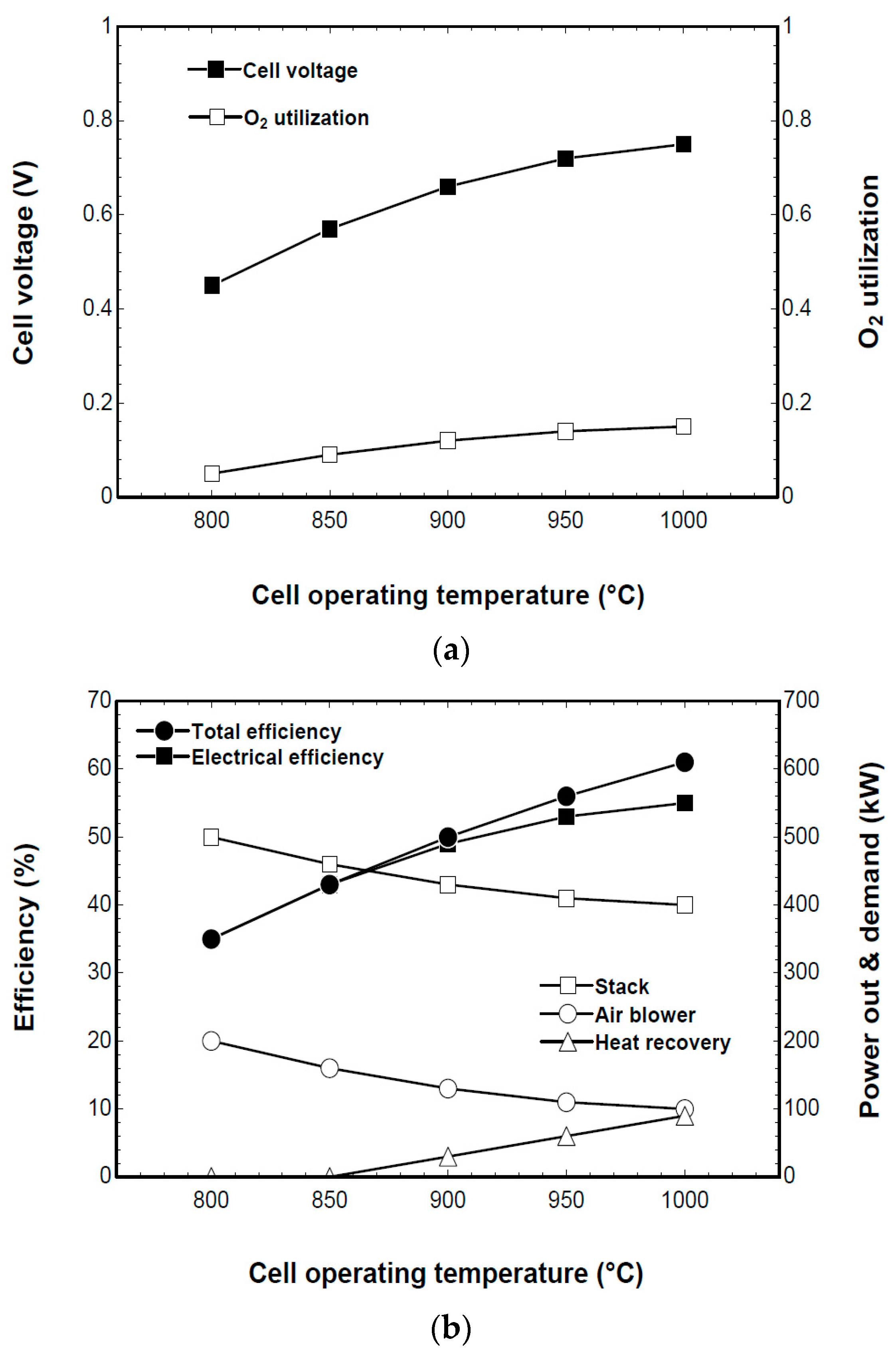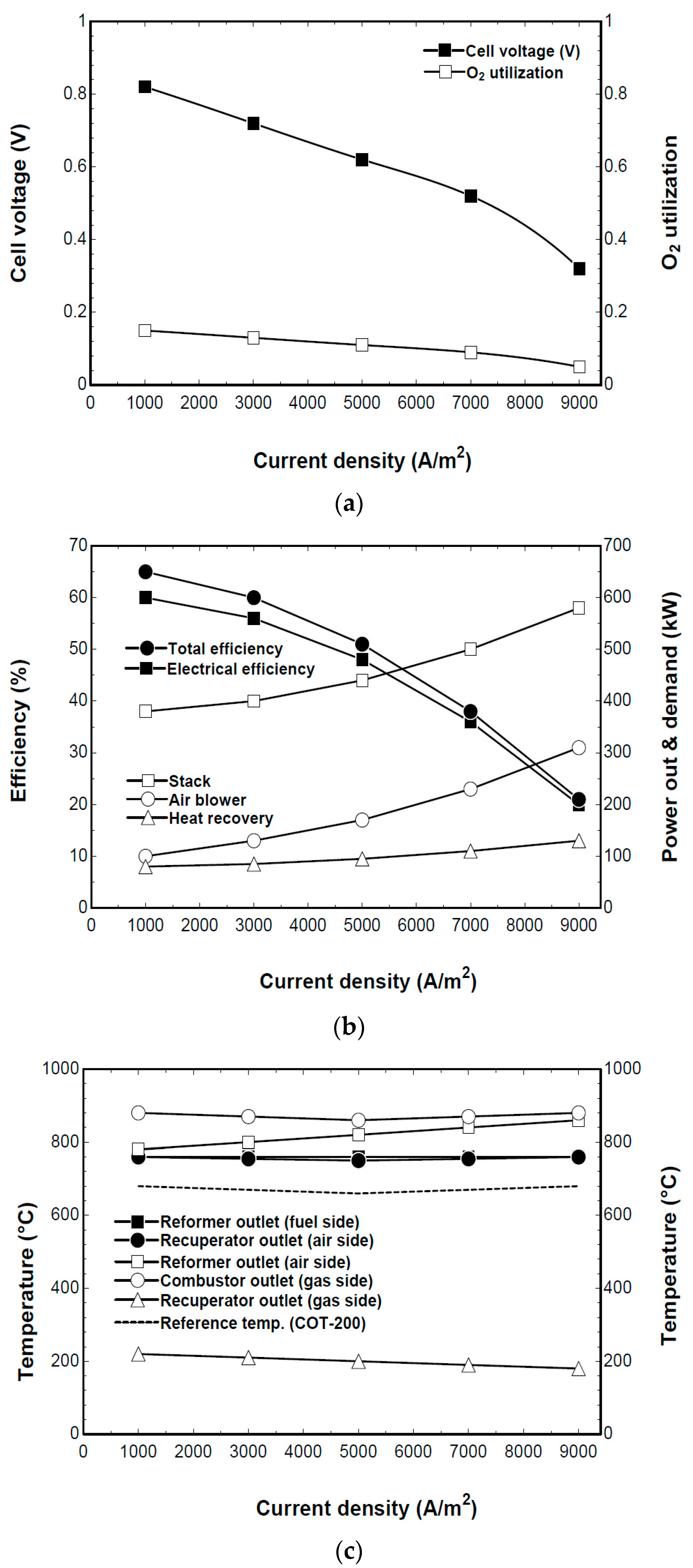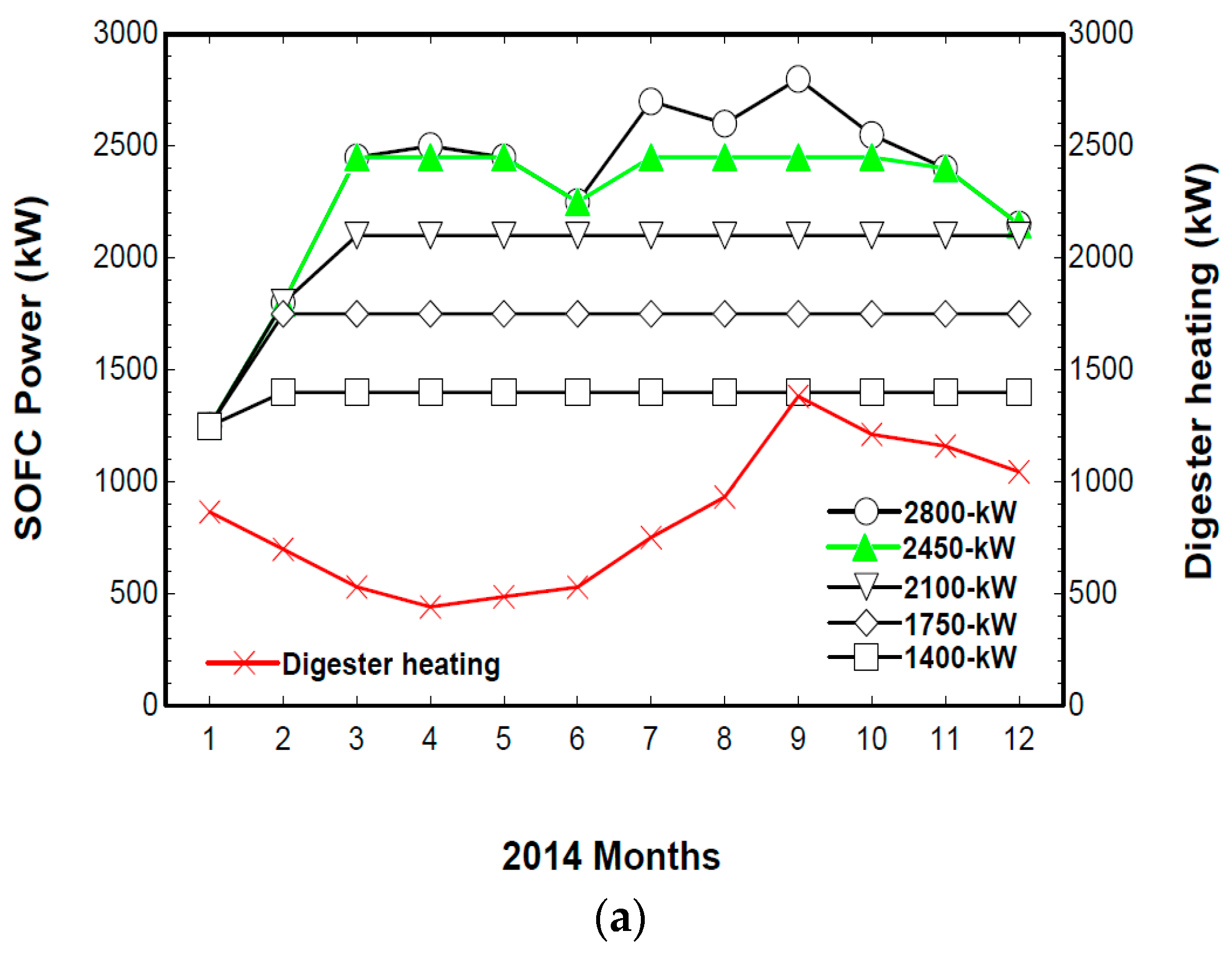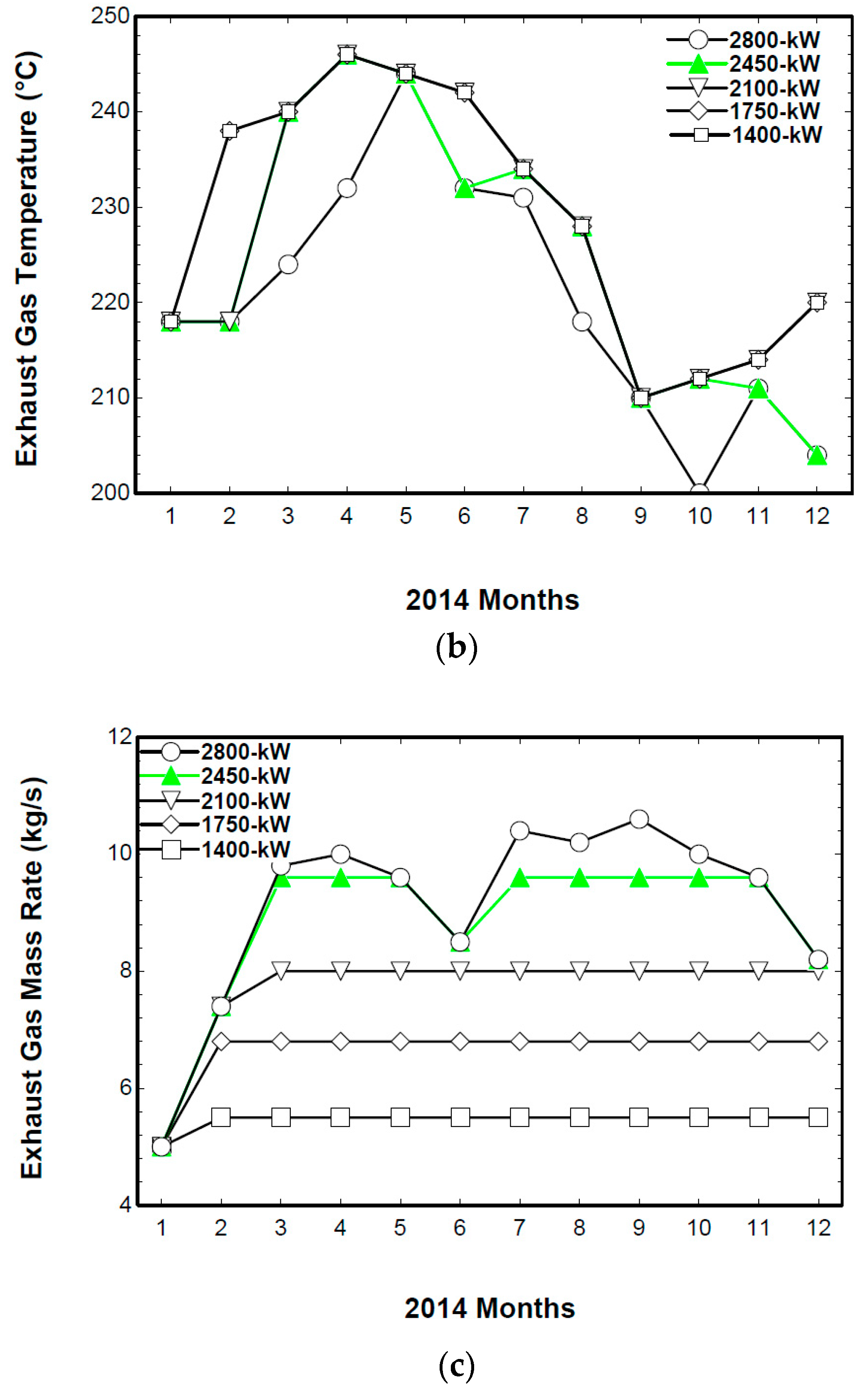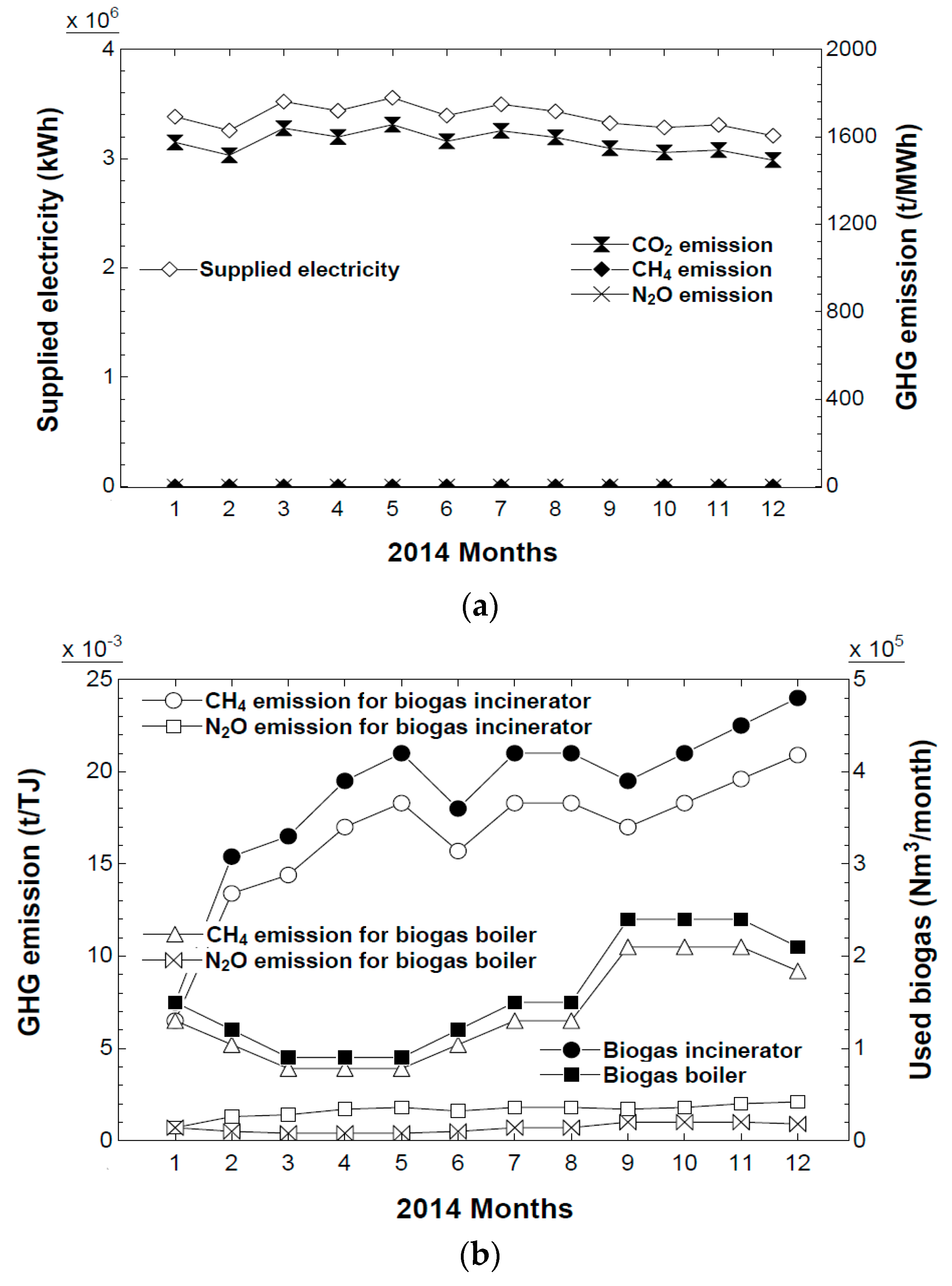1. Introduction
The anaerobic digestion of organic waste involves the fermentation of organic materials without the presence of oxygen. This process has widely been used as a method for the stabilization of sewer sludge since the early twentieth century. It has several advantages, such as reducing the volume of sludge, remediation, and the production of biogas, which is an energy byproduct that mainly consists of methane and CO
2 [
1]. The supply rate goal for new and renewable energy has been set to 20% by 2030, through the expansion of biogas production. The Korean Government aims to reduce CO
2 and greenhouse gas emissions by 37% below the “business-as-usual” level of 851 million tons by 2030 [
2]. Thus, a significant amount of attention has been paid to clean energy research and development, as well as projects related to reducing greenhouse gas emissions.
Reducing waste can be facilitated by using bio-gasification. In addition to greenhouse gas reduction, the production of new and renewable energy can be expected [
3]. Biogas can be used in boiler fuels, power generation and cogeneration in gas engines and turbines, and as fuel in fuel cells [
4]. Some of the biogas produced in Korea is used in boiler fuel to increase the temperature in digesters, and the rest is used in incineration treatment facilities. In recent years, the use of biogas has increased to connect city gas piping networks or to supply fuel for vehicles, with the development of technology that increases the purity of the methane in biogas [
5]. These efforts can improve the environmental impact and economic feasibility of using biogas.
One of the main uses of biogas is engine power generation. There is 6 kW of energy in 1 Nm3 of biogas, which produces 2.1 kWh of electricity, assuming a power generation efficiency of 35%. Since the mid-1980s, co-combustion power generation systems in diesel engines have be used in sewage treatment facilities. In the Su-Young wastewater treatment plant in Busan, a dedicated biogas engine with a capacity of 750 kW, was introduced in 2002. A gas engine with a capacity of 375 kW was installed in the Jeju wastewater treatment plant in 2005. A gas engine with a 280 kW engine was installed in the Jecheon wastewater treatment plant in 2007, and two gas engines with 1500 kW engines were installed in the Nanji Sewage Treatment Center. The number of biogas power plant facilities in Korea is growing, but the focus has been on gas engines rather than gas turbines and fuel cells.
The government has focused on expanding the facilities that treat organic wastes. However, there has not been much facility expansion for biogas production and utilization. Co-generation facilities that use biogas are expected to expand according to current policies. It is necessary to establish mid- to long-term planning for systematic and efficient progress through analysis of biogas production and utilization. According to the Policy of Energy Generation from Wastes from the Ministry of Environment, a 3Es paradigm that integrates the environment, economy, and energy has been adopted.
Fuel cells produce power using heat and electricity created by the electrochemical reaction of fuel and oxygen. Fuel cells have very high efficiency of up to 40–60%, and if the exhaust heat can be used, it can be converted to energy with up to 80% efficiency. The efficiency is higher than that of thermal power generation when fuel for power generation can be reduced and co-generation power can be obtained. Furthermore, the amounts of NOx and CO2 emitted are about 1/38 and 1/3 that of thermal power generation using coal. The noise is also very low, and nearly no pollution is emitted. It is thus considered a pollution-free energy technology.
A solid-oxide fuel cell (SOFC) is simpler than a molten carbonate fuel cell (MCFC), which must deal with CO
2 [
6]. Furthermore, the solid electrolyte is more convenient, and it has the highest efficiency of all fuel cells. Since the electrolyte is solid, there is no concern about leakage or humidification. A SOFC is a high-temperature fuel cell that is operated at around 700–1000 °C. The cell has high efficiency due to its low voltage loss as a result of the high working temperature.
SOFC systems directly fed by biogas have been verified as practicable for a variety of SOFC configurations in several studies. The combination of high CH
4 concentration and Viking producer gas, yields an encouraging possibility for a fuel for SOFCs [
7]. This possibility for use has already been reported by Hoffmann et al. who set a single fuel cell on pure gas from the Viking gasifier for 150 h without compromising the cell catalysts [
8]. A component of the SOFC modeling was performed using an electrochemical model, looking at the ideal operating utilization and full load effects [
9]. Shiratori et al. [
10] evaluated SOFCs fed by only biogas, with an internal reforming mode maximum of 800 °C to protect cell materials. They discovered that system models are useful and make up for weak research guiding single SOFC and hybrid systems over recent decades. Yi et al. [
11] investigated new incorporated H
2 reforming systems and showed that system efficiency drops by around 1.1% when using biogas instead of liquid natural gas.
Farhad et al. [
12,
13] set and operated a full and partial load analysis of single SOFC and hybrid systems, with combined heat and power (CHP), by a simulation. Vakouftsi et al. [
14] performed three case studies using computer models of existing states within an internal reforming SOFC system configuration that was fed according to a stream carbon ratio (SCR). The integrated system components were thermodynamically modeled under steady-state conditions. Mass and energy balances were applied for each component using lumped models.
Efforts have also been made to incorporate micro gas turbines (MGTs) with SOFCs to satisfy increasing demand for highly efficient energy production, along with reducing environmental pollutant substances. SOFC-MGT hybrid power systems, with outputs of tens to hundreds of electrical kilowatts, have been presented experimentally [
15,
16,
17]. Therefore, biogas is considered as one of the most promising renewable energy sources for distributed power generation and heat supply without additional fuels, and SOFC-MGT fueled biogas appears to be one of the best potential alternatives for distributed power generation and heat supply.
This study evaluated the performance of an SOFC hybrid system, using actual biogas operation data derived from the processing of food waste and sewer sludge. Data on greenhouse gas reduction was also provided, from the perspective of power production. Biogas from the examined treatment facility is not used for the purpose of energy production and is only incinerated to increase the temperature of a digester. Thus, the aim was to generate and use power directly, as well as to obtain thermal energy to increase the temperature in the digester, in order to recover waste biogas. This study also clarified the relationship between the scale of a plant and the optimal size of equipment.
5. Conclusions
The sewage treatment plant in Busan, Korea, has an annual sludge-treatment capacity of 132,601,000 m3. It can produce biogas through the anaerobic digestion of sludge, but the generated biogas is recovered and used as fuel to increase the temperature in the digester, and the rest is burned and dumped at the waste gas incinerator. In this study, the biogas produced was recovered and used to generate power through an SOFC.
The appropriate parameters of a 350 kW SOFC were an S/C of 3, cell operating temperature of 950 °C, current density of 3000 A/m2, preheater temperature efficiency of 85%, and hydrogen fuel utilization rate of 80%, according to the simulation. We also analyzed the performance of different sizes of SOFCs for an anaerobic digester with a 28,000 m3 capacity. The 2450 kW SOFC system was set to its maximum capacity, with the available amount of biogas and the heat of the exhaust gas used to heat the anaerobic digester; however, the amount of digester heat decreased in summer because of the high air temperature. Up to 55% of the total power usage could be produced via biogas, and a 45% reduction in CO2 was achieved. This study showed that the SOFC system could be sufficiently competitive as a distributed power supply device within a few years, due to mass production and technical advancement.
